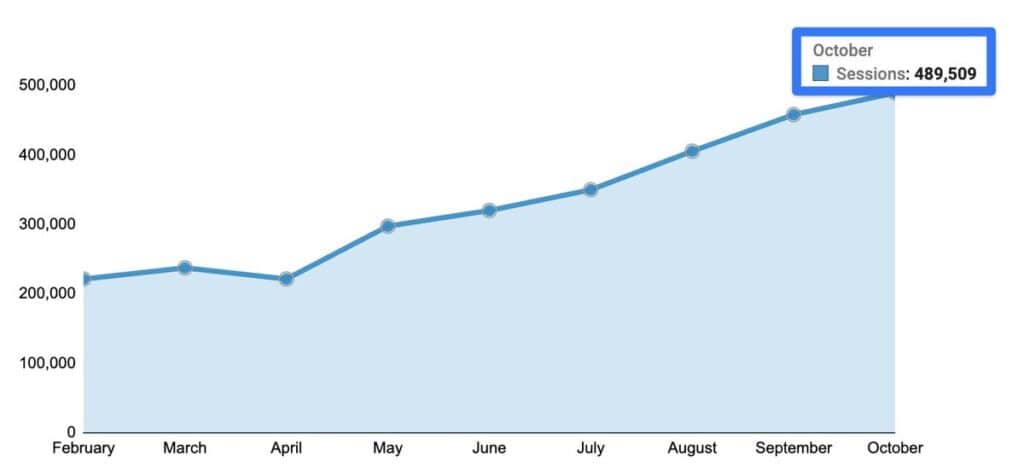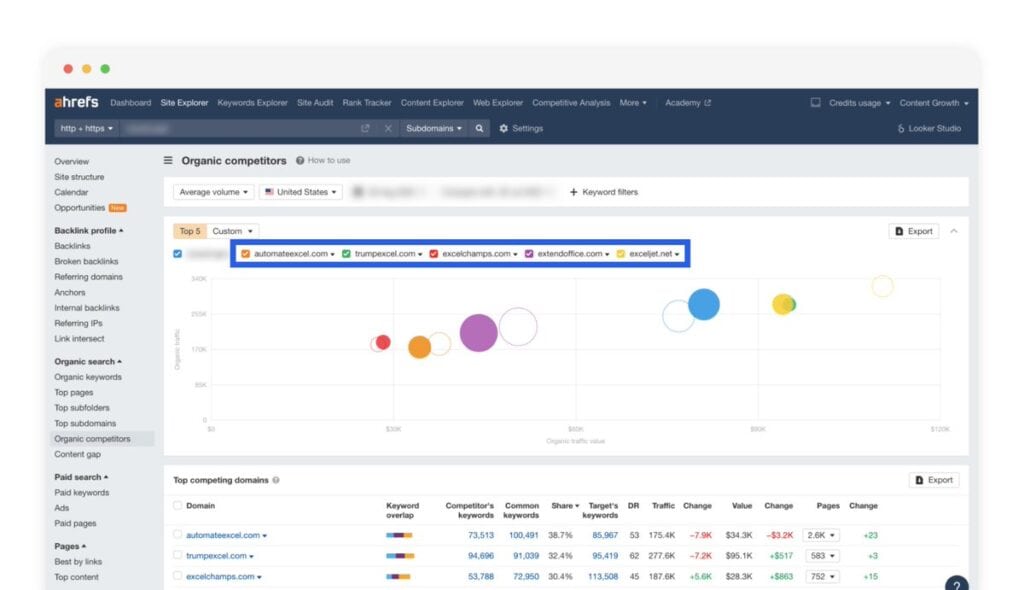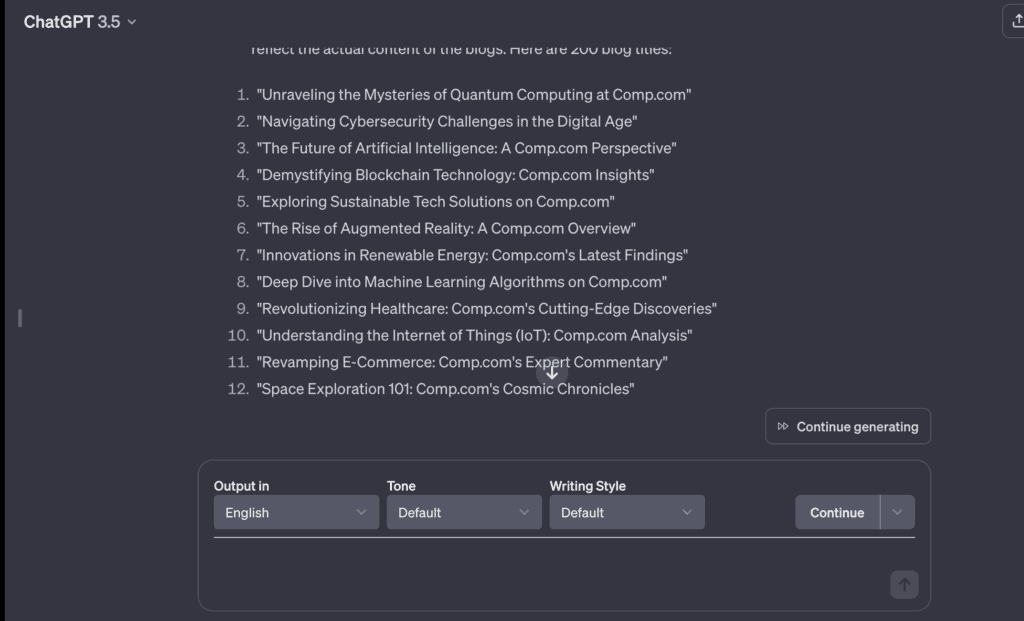I recently stumbled upon a Twitter thread that caught my attention, posted back in November. In this thread, Jake Ward shared a fascinating story about an SEO strategy that he referred to as an “SEO Heist.” Basically what he shared was how to steal traffic and visitors of competitors website.
He claimed that they successfully diverted a whopping 3.6 million in total traffic from a competitor and got 489,000 traffic in October alone.
Now, it’s essential to clarify that the content I’m sharing with you is for educational purposes only.
So, let’s delve into the details of this intriguing SEO hack, keeping in mind the educational nature of the information.
Key Takeaways:
- Jake Ward’s SEO strategy that diverted 3.6 million visitors from a competitor’s traffic to his own website.
- The method involves using AI tools for keyword research and content creation.
- Learn how to steal traffic and visitors of competitors website.
SEO Heist: Stealing 3.6 Million from Competitor’s Website Traffic
When I found this twitter thread, it blew my mind! This method is like one of those few things that is already in front of us but we fail to utilise it to it’s full extent.
Jake Ward and his team started by exporting their competitor’s sitemap, converting their URLs into article titles, generating 1,800 articles using AI technology, and finally, they showcased the results.
After 18 months, they managed to acquire a total of 3.6 million visitors. It seems that they are using an SEO tool to check competitor website traffic and their own traffic. The term “stolen” implies that the traffic has been moved from their competitors’ website to their own, resulting in a monthly traffic of 490,000. This is a substantial amount of traffic that can generate significant revenue, even with a low conversion rate.
In his writing, he explains how they accomplished this manually 18 months ago, but now there are tools available to automate almost the complete process.
How they got 3.6 Million of Competitor’s Website Traffic

Here’s how they did it:
#First
They identified a competitor whose website ranked for the keywords they aimed to rank for. In the image provided, it appears that he is using AhRefs to find competitor websites.
#Second
What they did next was locate their competitor’s sitemap.
#Third
The third thing was to export the sitemap by searching for a Google tool that converts XML to CSV. By using a free XML to CSV converter, the sitemap can be exported as a CSV file.
#Fourth
Additionally, the fourth step involves generating article ideas using a list of competitor URLs.
Jake Ward’s team did this by using a paid tool called “Byword“. This tool generates article titles and outlines in bulk based on the competitor URLs provided. For example, the URL for “google-adsense-guide” might be translated into an article titled “The Complete Google Adsense Guide for Monetising your Website.” Now you have an article that aligns with the key phrase.
Here’s the juicy part – the results. They claim to have published a whopping 1,800 articles in just a few hours. And get this, since then, they’ve hit a monthly traffic jackpot of 490,000 and a grand total of 3.6 million since kickstarting this strategy. Oh, and did I mention 13,000 keywords on page one of Google? Impressive, right?

Now, you’re probably thinking, “Can’t I do this manually with something like ChatGPT?” Well, stick around, because I’m going to guide you through that process.
#Fifth
Now, onto the fast lane – publishing. You already know how this is done.
Quick overview: Peek at your competitor’s sitemap, transform it, generate ideas, craft articles, and hit that publish button. Simple, right? I’m even going to show you how you can pull this off using ChatGPT, GPT-4, your own tools, and your own website.
Ready for the ride? Let’s do this together!
Here’s How they could have done this using ChatGPT
Step 1: Spot the Competition
This is the first crucial step, identifying your competition. Look for a player in the industry with a robust online presence.

You can use tools like AhRefs or SEMrush, or manually search on Google to find a competitor’s website traffic.
For our example, let’s call this formidable contender “Comp.”
- Objective: Identify a competitor with a strong online presence
- Example: Let’s call them ‘Comp’
Step 2: Map the Territory
Now that you’ve pinpointed your rival, it’s time to chart their content landscape. Navigate to their website’s URL and search for the SLS sitemap.xml. To do this, add “/sitemap.xml” to their domain name.

Among the various sitemaps available, select the one labeled “post SLS sitemap.” This will serve as the treasure map for your content strategy.
Remember that this is a crucial step in getting competitor’s website traffic.
- Objective: Obtain the competitor’s website sitemap for a content blueprint
- Action:
- Zoom into the competitor’s URL.
- Search for SLS sitemap.xml.
- Explore and select the sitemap with the desired article URLs.
- Example: If ‘Comp’ has seven sitemaps; choose the one labeled “post SLS sitemap.”
Step 3: Extracting the Goldmine
Now, with the chosen sitemap in hand, copy the URL and convert it to CSV using XML to CSV tools. Open the CSV in Google Sheets, eliminating unnecessary data and retain only the valuable URLs.
- Objective: Extract article URLs for potential content generation.
- Action:
- Copy the URL and convert it to CSV using free XML to CSV tools online.
- Open the CSV in Google Sheets and delete unnecessary data, keeping only the URLs.
Step 4: Utilise Power of ChatGPT
Now that you have a list of potential article title, comes the creative part. Use the power of ChatGPT to generate potential article titles based on the provided URLs.
A simple prompt asking for titles can yield a wealth of ideas. For instance, inputting Comp’s URLs into ChatGPT can provide unique and engaging article title suggestions.

- Objective: Generate potential article titles using ChatGPT.
- Action:
- Write a prompt asking for article titles based on the provided URLs.
- Use the output for potential article ideas.
- Example: Input the URLs into ChatGPT and receive article title suggestions.
Step 5: Crafting Articles – The Manual Approach
For a more hands on touch, you can choose a title generated by ChatGPT, such as “Smart Ways to Write Blog Content.” Create a new ChatGPT conversation, requesting a 1000 word article around this title. After generating, copy and paste the article onto your website.
This manual approach ensures personalised and unique content for each selected title and this is the last step in getting competitor’s website traffic.
- Objective: Write articles manually for selected titles.
- Action:
- Choose a title (e.g., “Smart Ways to Write Blog Content”).
- Create a new ChatGPT conversation, asking to write a 1000 word article around the title.
- Copy and paste the generated article onto your website.
- Example: Craft unique articles for each title manually.
With this step, you have done your part in what you call a “SEO Heist” and now it’s upto Google to rank your articles.
Now I may walk you through the more important part of this article.
The Ethical Quandary
At the heart of the matter lies a moral dilemma. Is it ethical to use a competitor’s website traffic and content to bolster your own online presence?
While some argue that it’s a fair game in the competitive arena, others deem it a breach of trust and intellectual property. And I honestly, agree with the second group.
Even Jake Ward got a major backlash after this ‘SEO Heist’ came in public eyes.
Consequences of Unethical SEO Practices
- Legal Ramifications: Utilising a competitor’s content to get competitor’s website traffic without proper attribution or permission can lead to legal consequences. Intellectual property laws protect original content, and unauthorised use may result in legal action.
- Search Engine Penalties: Search engines prioritise user experience, and unethical SEO practices can incur penalties. Algorithms are designed to detect manipulative strategies, potentially resulting in a significant drop in rankings.
- Long Term Sustainability: While the initial gains may seem enticing, the long-term sustainability of a strategy built on unethical practices is questionable. Building a genuine audience base is a more sustainable approach.
Ethical Ways for SEO Success
Checking competitor’s website traffic is a common practice in SEO but using or ‘stealing’ it in unethical ways is immoral according to us. You should prioritise using ethical ways for success in SEO industry.
1. Create Original Content:
You should Invest in creating high quality, original content that provides value to your audience. Authenticity builds trust and fosters a loyal following.
You can read our article that will tell you about content marketing trends in 2024 and how you can develop content to get an edge in 2024.
2. Optimize Responsibly:
Prefer ethical SEO practices, focusing on optimising your own content rather than exploiting other’s.
You can use our SEO guide to help you walk through your journey to first page of Google.
3. Collaborate Ethically:
Instead of trying to gain from competitor’s website traffic and content unethically, explore collaborations and partnerships with industry peers in a transparent and ethical manner. You can help each other in gaining authority and traffic from the content you create.
Conclusion: Should you Utilise Competitor’s Website Traffic?
As I mentioned before, checking competitor’s website traffic and studying it in ethical ways has always been a practice is SEO, but the recent unethical ways that try to drain competitor’s website traffic are deemed immoral by many industry leaders and experts.
While the temptation to employ competitive SEO strategies may be strong, the ethical implications and potential consequences cannot be ignored. Balancing growth with ethical considerations ensures that success is achieved with integrity, fostering a sustainable and trustworthy online presence.
After all, in the ever evolving digital landscape, a commitment to ethical practices is the key to long term success.
Resources: Jack Ward’s twitter thread
FAQs: Question and Answers
Q: Can you use AI tools for an SEO strategy to divert competitors’ website traffic ethically?
A: Yes, AI tools can be used to ethically divert competitors’ website traffic by creating original content inspired by competitor analysis, focusing on adding value and avoiding direct copying or unethical practices.
Q1: How can AI tools enhance your SEO strategy?
A1: AI tools can significantly enhance your SEO strategy by automating content creation, keyword research, and competitor analysis, providing insights to create targeted content that meets user intent and improves search rankings.
Q2: What are the ethical considerations in using competitors’ website traffic for SEO?
A2: Ethical considerations include avoiding plagiarism, ensuring content is original and adds value, respecting copyright laws, and focusing on creating content that benefits users rather than manipulatively diverting traffic.
Q3: What are the potential consequences of unethical SEO practices?
A3: Unethical SEO practices can lead to legal repercussions, penalties from search engines like Google, including lower rankings or de-indexing, and damage to your brand’s reputation and trustworthiness among users.
Q4: How can you ethically use competitor analysis to improve your SEO?
A4: Ethically using competitor analysis involves gathering insights on content gaps, keyword opportunities, and user engagement strategies to inform your content creation, focusing on delivering superior value and user experience without copying competitors’ content.

